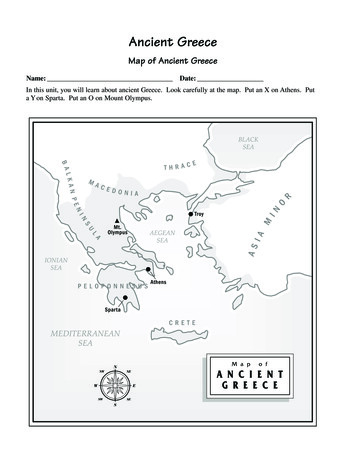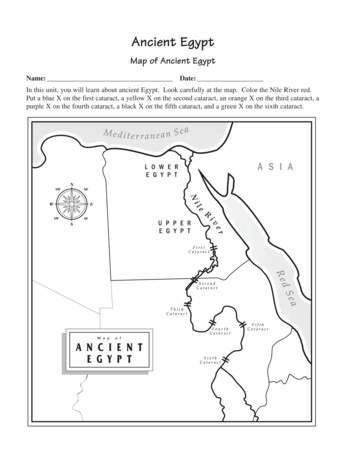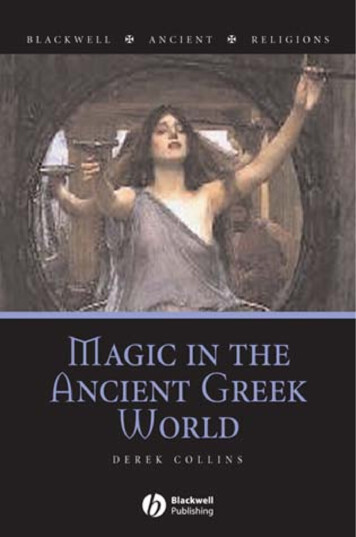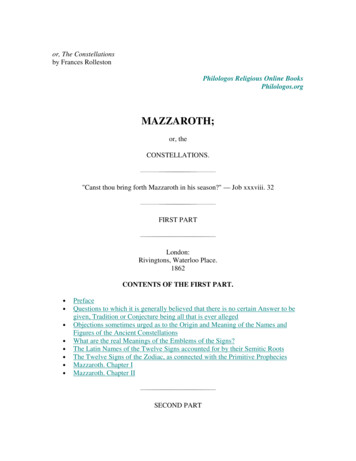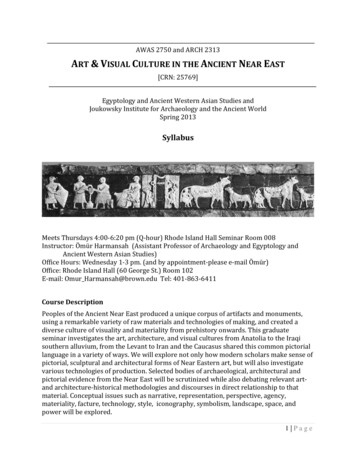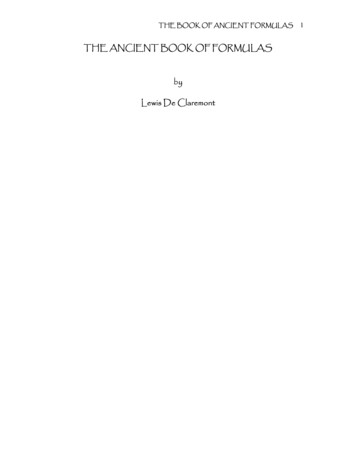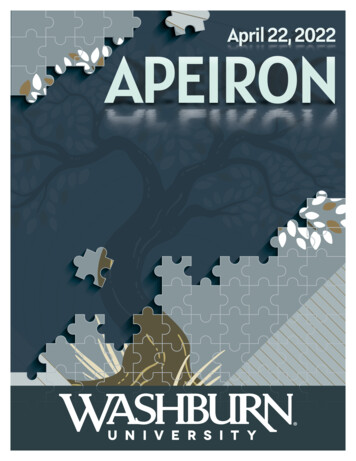
Transcription
The Apeiron is an ancient term offered by Anaximander of Miletus inthe 6th century B.C. that embraces the spirit of this forum. As with theApeiron, which is infinite and boundless, all inclusive, eternal, andunaging, this forum is designed to be inclusive with respect to studentresearch, scholarship, creative activities, and community engagement.It is dedicated to the proposition that students are capable of work thatknows no limits and transcends all boundaries.Each student participant in the Washburn University Apeiron hasworked on his or her project under the supervision of a faculty mentor.The projects, which have been reviewed by the faculty, demonstratecreativity, originality, and a level of work superior to that normallyexpected of students. Today’s presenters exemplify the spirit of theApeiron.www.washburn.edu/apeiron The Greek Alphabet bdaMu nal cover art designed by Christina Noland.
Table of ContentsPageWashburn University Campus Map . 2Schedule of Events 3Last Lecture . 4Fine Arts Presentations (Abstracts) 5Schedule of Oral Presentations . 7Oral Presentations (Abstracts) 8Poster Presentations (Abstracts) 16Reception Menu . 37Apeiron Committee . 38Index of Presenters and Mentors . 391
AB - Art BuildingBE - Benton HallBP - Bianchino PavilionBT - Bennet Computer CenterBTAC - Bradbury Thompson Alumni CenterCA - Carnegie HallCH - Carole ChapelFF - Fally FieldFS - Facilities ServicesGF - Gahnstrom FieldGC - Garvey Fine Arts CenterHC - Henderson Learning Center IAF - Indoor Athletic Facility IH - International HouseJ} KBI - KBI Forensic Science CenterKH - Kuehne HallLA - Law SchoolLC - Lincoln HallLEE - Lee ArenaLLC - Living Learning CenterMA - Mabee LibraryMB - Moore BowlMO - Morgan HallMU - Mulvane Art MuseumNG - Neese Gray TheatrePC - Petro Allied Health CenterRB - Rita Blitt GallerySC - Stauffer Commons Food Court1700 SW College Ave., Topeka, Kansas 66621 785.670.1010ASHBURN UNIVERSITY CAMPUS MAP - Accessible EntranceX Entrance Closed0 Street/Parking ClosedAA/J. - Alpha DeltaAct - Alpha Phi/J.1 - Delta GammaCl /J.0 - Phi Delta ThetaLCl E - Sigma Phi EpsilonZTA - Zeta Tau AlphaSR - Student Recreation & Wellness CenterST - Stoffer Science HallTC - Tennis CourtsTV - KTWU Television StudioUN - Memorial UnionWC - White Concert HallWFH - Whiting Field HouseWH - West HallWUF - Washburn University FoundationWV - Washburn VillageVS - Yager Stadium
April 22, 2022Schedule of Events9:30 a.m.Student RegistrationMemorial Union, Washburn A & B Lobby10:00 a.m.Poster SetupMemorial Union, Washburn A10:30 a.m. – 12:30 p.m.Fine Arts PresentationsCarole Chapel1:00 p.m. – 3:00 p.m.Oral PresentationsHenderson Learning Resources CenterRooms 107, 118, 204, 2083:00 p.m. – 3:45 p.m.WelcomeMemorial Union, Washburn BDr. Courtney SullivanChair, Apeiron CommitteeRecognition of Student DesignersRob CoffeltGraphic Designer, University Mail & Printing ServicesStudent Designer:Christina NolandIntroduction of Last LectureEric McHenryLast LectureThomas AverillProfessor Emeritus of English3:45 p.m. – 5:00 p.m.Poster Session and ReceptionMemorial Union, Washburn A3
Last Lecture“Writing Lessons from Mt. Hope Cemetery”presented byThomas Averill, MA, MFAProfessor Emeritus of EnglishMemorial Union – Washburn B3:00 pmThomas Fox Averill is Professor Emeritus of English atWashburn, where he taught courses in Creative Writing andKansas Studies for 37 years. Educated at the University ofKansas (BA/English, 1971; MA/English, 1974) and the Universityof Iowa Writers Workshop (MFA/Fiction, 1976), he is an O. HenryAward short story writer and the author of 10 books, most recentlythe novel Found Documents from the Life of Nell Johnson Doerr.He helped found and was the first director of the Washburn Centerfor Kansas Studies. In 2010 he created the Thomas Fox Averill Kansas StudiesCollection at Mabee Library, donating his large library of Kansas novels, plays,collections of poetry and fiction, histories, biographies, memoirs, letters, scholarlyarticles, collected folklore, manuscripts and ephemera gathered over 40 years of anabiding interest in all things Kansas. 4
Fine Arts Presentations10:30 a.m. – 12:30 p.m.Carole ChapelWTE denotes Washburn Transformational ExperienceModerators: Julie Noonan and Silas Huff 10:30 a.m. – 11:30 a.m.Carole ChapelDevising The Write CinderellaMadeline P. Dumler, Erin Watts, Josh Staats, Grey E. McCollum,and Illiana Victoria GallardoMentor: Julie Noonan, TheatreWTEThe Write Cinderella is a fully-student devised play. The play was developed through “moment work,” acontemporary devising method created by the Tectonic Theatre Company. This performance will presentthe play and answer questions about the devising process. The play is in one-act and tells the story of twostep-sisters trying to connect by reading their favorite childhood book. Conflict ensues when one of thesisters desperately wants to try and change the story to be more exciting, while the other would ratherkeep the story the way it’s always been. Performers include: Madeline Dumler, Illiana Gallardo, GreyMcCollum, Josh Staats, and Erin Watts. This production will be traveling to and representing WashburnUniversity Theatre at the Edinburgh Fringe Festival in Scotland in August of 2022 and also be presentedfor several Topeka community groups in April. 11:35 a.m. – 12:05 p.m.Carole ChapelThe Baroque Era: The Coming of the ViolaAllison L. GalvinMentor: Silas Huff, MusicMy presentation will bring us back to the Baroque Era (1600-1750) and take a look at what the composerGeorge Philip Telemann created. Telemann wrote both instrumental and vocal compositions, a whoppingtotal of 3,000 pieces. I will talk about some of Telemann's major accomplishments and why I considerhim the King of the Baroque Period. I plan to demonstrate his geniality by performing several movementsfrom his Viola Concerto in G Major.5
12:15 p.m. – 12:30 p.m.Carole ChapelSelections from España by Isaac Albeniz (Arr. by Bill Holcombeand Bill Holcombe Jr.)Sarah Reineke, Kayden A. Matney, Dylan C. D. Rizzo, Faith Haller,and William CasonMentor: Rebecca Meador, MusicThe Washburn University Honors Woodwind Quintet presents selections from España by Isaac Albeniz,and arranged for woodwind quintet by Bill Holcombe and Bill Holcombe Jr. This presentation willinclude a brief introduction on how musicians communicate during a performance and the importance ofunderstanding historical context. The session will focus on a performance of the selected materials. Aquestion-and-answer session will follow. Ensemble Members: Faith Haller, Flute; Sarah Reineke, Oboe;William Cason, Clarinet; Dylan Rizzo, Bass Clarinet; Kayden Matney, Horn.6
Schedule of Oral Presentations(HC Henderson Learning Resources Center)Time/Location Presenter1:00 pm – 1:20 pmHC 118Rachel L. Zimpfer andKeetan B. MunsellHC 204HC 107Kassadee C. ClarkBijaya BasnetHC 208Taton Smith1:25 pm – 1:45 pmHC 118Rajesh KandelHC 204HC 107HC 2081:50 pm – 2:10 pmHC 118HC 204TitleProduction of Photodynamic AntimicrobialMaterial Through Attachment of Photosensitizersto Glass via Amide LinkageThe Women who Contributed to D-DayDetermining the Apoptotic Timeline in BreastCancer Cells Undergoing Photodynamic Therapyvia Optical Scatter ImagingAlternative Truths: A Case Study in the Dangersof PseudoarchaeologyElizabeth Gail Pendergrass andEliana PendergrassJustin A. Smith, Skyler J.Saunders, Eric R. Tilton, andTilak ThapaEmily Myers and Emma SaffronMorrisseyRyan HallerCheyanne ColwellHC 208Joshua Meinhardt, RyanMurphy, and Kevin A. ConnerSidney R. Cavner2:15 pm – 2:35 pmHC 118Ethan H. NelsonHC 107HC 204HC 107HC 2082:40 pm – 3:00 pmHC 118HC 107HC 208Jessie RevellMara S. Gilbreath, Skyler J.Saunders, Alejandra AlonsoOlivas, and Vladislav BaidinQuay'Shawn A. AkinsAlex GriffithsJustin A. Smith, Edward W.Baker, Angelica Faye Comahig,and Brett KulpVictor Ramirez7A Micro Fabry-Perot Cavity for ChemicalCharacterizations of Nanoscale Particles viaRaman SpectroscopyExploring the Representation of Women inHistorical and Art Museums Across FranceAppsterchefTruth and NAGPRA: Washburn’s Collaborationwith the Kansas Historical SocietyAn Exploration of the Tutte PolynomialWorld War Two's impact on Women's Fashion inFranceCrypTechAnalysis of the Remains of the Koerner MoundSiteSelf-Compassion As An Intervention AgainstProcrastination Among American CollegeStudentsLost children of ParisGaming Habits and Education StructurePreferencesA Trip to NOLA: Black and White and in ColorTrans Men’s Perspectives on Masculinity: Sexism,Male Privilege, and Marginalized MasculinitiesPublic Perception of Right to Repair and itsEffects on PurchasingTours by Marguerite: An Authentic Telling of theCreole Culture in New Orleans
Oral Presentations1:00 p.m. – 3:00 p.m.Henderson Learning Resources CenterWTE denotes Washburn Transformational ExperienceSession 1:00 p.m. – 1:20 p.m.Moderator: Jennifer WagnerHenderson Learning Resources Center, Room 118Production of Photodynamic Antimicrobial Material Through Attachmentof Photosensitizers to Glass via Amide LinkageRachel L. Zimpfer and Keetan B. MunsellMentor: Sam Leung, ChemistryIn the past few decades, the use of photodynamic action has been directed toward cancer therapy due tonon-invasive and specific cancer treatment potential. More recently, however, photodynamic action hasbeen applied in an antibacterial setting. The current idea for application of photodynamic action is toattach a photosensitizer to a common surface such as glass or cloth. Such surfaces could be antibacterialin the presence of light with the appropriate wavelength. In this work, attempts were made to derive glassslides with 3-aminopropyltriethoxysilane (APTES) in order to provide amino groups on the glass surfacethat will allow the attachment of a photosensitizer through an amide linkage. Generally, a harsh cleaningprocedure on glass was performed to remove any obstructions prohibiting proper interaction between thehydroxyl groups on the silica based glass surface and ATPES. The clean glass was then treated withAPTES. Subsequent attachment of methyl red (a model compound for a photosensitizer) using adicyclohexylcarbodiimide (DCC) coupling reaction was unsuccessful. Currently, reliable procedures forthe application of the APTES solution to glass and for the confirmation of amino groups on the glasssurface are being investigated. 1:25 p.m. – 1:45 p.m.Henderson Learning Resources Center, Room 118A Micro Fabry-Perot Cavity for Chemical Characterizations of NanoscaleParticles via Raman SpectroscopyRajesh KandelMentor: Hoang Nguyen, ChemistryRaman spectroscopy is a powerful analytical technique that detects a shift in optical wavenumber betweenthe incident light and light scattered from the analyte. The Raman shift is dependent on the vibrationalmode of the chemical bonds inside the analytes and capable of generating a chemical fingerprint of8
molecules. The resulting Raman spectrum enables the chemical identification of various analytes,allowing for a wide range of applications in chemistry and biological studies. However, conventionalRaman requires a relatively high sample concentration, making it not suitable for direct cellularinvestigation. A micro Fabry-Perot cavity system could amplify the optical Raman signal when thescattered light from the sample meets the resonance condition of the cavity. A Fabry-Perot simple cavityis formed when two highly reflective surfaces are positioned within a few micrometers facing oneanother. The resonance condition of the cavity can be fine-tuned by fixing one mirror and moving theother mirror precisely using a shear piezo. The precision in the movement of the mirror-on-shear-piezowas calibrated with a motion-voltage response rate of 13.41 nm per V. However, we are working onimproving the stability of the mirrors to allow for an more stable cavity and more well-definedresonances. 1:50 p.m. - 2:10 pm.Henderson Learning Resources Center, Room 118An Exploration of the Tutte PolynomialRyan HallerMentor: Jennifer Wagner, Mathematics and StatisticsThe Tutte Polynomial is a mathematical tool used in Graph Theory. It can be used to describe theconnectivity of a graph and determine other useful information about it, such as the number of spanningtrees of a graph, the chromatic polynomial, and the number of acyclic orientations of a graph. Here, theTutte Polynomial will be constructed using the operations of deletion and contraction, and some of itsapplications will be explored. 2:15 p.m. – 2:35 p.m.Henderson Learning Resources Center, Room 118Self-Compassion As an Intervention Against Procrastination AmongAmerican College StudentsEthan H. NelsonMentor: Michael McGuire, PsychologyWTESelf-compassion, which is the application of compassion towards oneself, has been associated withnumerous benefits toward mental well being. However, self-compassion has not been well-researched asan intervention against procrastination, an issue affecting many people, especially college students. Thisstudy aimed to investigate how self-compassion exercises would impact the level of procrastinationcollege students had when completing general knowledge quizzes. After students took an initial survey, anegative correlation was found between self-compassion scores and the level of procrastination in astudent. However, to compare the procrastination levels of students in a control group versus a selfcompassion intervention group when taking the general knowledge quizzes, the sample size was too smallto draw conclusions. Future studies should aim for larger sample sizes and better completion rates fromparticipants in order to have findings.9
2:40 p.m. – 3:00 p.m.Henderson Learning Resources Center, Room 118Trans Men’s Perspectives on Masculinity: Sexism, Male Privilege, andMarginalized MasculinitiesAlex GriffithsMentor: Michael McGuire, PsychologyWUmesterWTEEvery person carries with them a series of intersecting identities (e.g. race, class, age, body type,sexuality) which serve to either marginalize or elevate them above others. This includes the dimensions ofgender and social presentation. This presentation synthesizes the experiences of trans men specifically how they are like cisgender men in their performances of masculinity, how they are different, and thecomplexities of their experiences with privilege and marginalization. Past research has found thattransgender men are closer in cognition to cis men than women, and this review adds depth by findingthat both cis and trans men have similar experiences navigating hierarchies of masculinity. Pre-transitionexperiences as well as the process of embracing or changing these identities can give trans men insightinto the inner workings of masculinity which are explored here.Session Moderator: Craig Carter 1:00 p.m. – 1:20 p.m.Henderson Learning Resources Center, Room 204The Women Who Contributed to D-DayKassadee C. ClarkMentor: Kerry Wynn, HistoryWTEThe presentation will show how the women of England’s Special Operations Executive, F-Section,assisted the Allied Forces during WWII and the successful infiltration of D-Day. 1:25 p.m. – 1:45 p.m.Henderson Learning Resources Center, Room 204Exploring the Representation of Women in Historical andArt Museums Across FranceElizabeth Gail Pendergrass and Eliana PendergrassMentors: Kerry Wynn, History; Courtney Sullivan, Modern LanguagesWTEIn this presentation, we will be exploring the representation of women in the different art and historymuseums we visited on our trip to Normandy and Paris, France. We will delve into the stories of some ofthe women who were represented and the artwork. This presentation will also provide statistical analysis10
on the representation of women at the different museums and ask the question of whether it is enoughwhen you weigh the important significance the women had in the history of France. 1:50 p.m. – 2:10 pm.Henderson Learning Resources Center, Room 204World War Two's Impact on Women's Fashion in FranceCheyanne ColwellMentor: Kerry Wynn, HistoryWTEThe study focuses on how World War II affected women's fashion and created new fashion trends for thefuture. Materials women would use for clothing were no longer available to them and turned into militaryuse. 2:15 p.m. – 2:35 p.m.Henderson Learning Resources Center, Room 204Lost Children of ParisJessie RevellMentors: Kerry Wynn, History; Courtney Sullivan, Modern LanguagesWTEDuring the initial takeover of the Vichy government in an effort to further tie themselves to Germany,Marshal Petain and the Vichy government put into place a system of efforts meant to deport Jewishimmigrants and non-French citizens. As the Nazi leadership became more involved in the workings of theFrench government, they began the process of deporting all Jewish citizens of France. Paris had a largepopulation of Jewish citizens and among them some three thousand children lost their lives afterdeportation to Auschwitz.Session 1:00 p.m. – 1:20 p.m.Moderator: Nan SunHenderson Learning Resources Center, Room 107Determining the Apoptotic Timeline in Breast Cancer Cells UndergoingPhotodynamic Therapy via Optical Scatter ImagingBijaya BasnetMentor: Vincent Rossi, Physics & AstronomyLight scattered by cells provides a deeper insight into cellular structure. Optical Scatter Imaging (OSI)provides a unique tool for analyzing scattered light in cellular imaging. Observed changes over time ofthe light scattered by cells are indicative of morphological changes within cells in time. We have designed11
and constructed a Digital Fourier Holographic Microscope (DFHM) for cellular imaging. With our systemwe can measure morphological changes in cells in real time and generate holographic reconstructions ofcells. We are interested in the morphological changes in breast cancer cells undergoing aminolevulinicacid (ALA) mediated Photodynamic Therapy (PDT). ALA is a photosensitizing agent that when exposedto light converts oxygen molecules to Reactive Oxygen Species (ROS), which damage cells. DuringALA-mediated PDT, mitochondria are the targeted site for damage, thereby causing cells to die viaapoptosis. We are using the DFHM and OSI in order to observe the mitochondrial swelling associatedwith the onset of apoptosis in ALA-mediated PDT of breast cancer cells. This project aims to determinethe timeline of the onset of apoptosis in breast cancer cells undergoing ALA-mediated PDT. 1:25 p.m. – 1:45 p.m.Henderson Learning Resources Center, Room 107AppsterchefJustin A. Smith, Skyler J. Saunders, Eric R. Tilton, and Tilak ThapaMentor: Nan Sun, Computer Information SciencesAppsterchef is a mobile application designed to make finding and creating recipes simple and powerful.This application allows users to search for recipes by name or ingredient, add and share new ingredientsand recipes, and create a shopping list from recipes or ingredients. After selecting a recipe to view, userswill see all ingredients required for the recipe, their respective measurements, instructions, images, anduser comments and ratings. Appsterchef is developed using Android Studio and implements Google’sFirebase database. 1:50 p.m. – 2:10 pm.Henderson Learning Resources Center, Room 107CrypTechJoshua Meinhardt, Ryan Murphy, and Kevin A. ConnerMentor: Nan Sun, Computer Information SciencesCrypTech is a lightweight, user-friendly Java program that is designed to encrypt, decrypt, and hash files.It features a mainframe that prompts the users to select files they wish to manipulate and process the filesbased on user choices of algorithms. The program features multiple encryption and decryption algorithmswhich help keep information that you want encrypted away from other programs that do not have thecorrect decryption algorithms. The hashing function is to help the users determine if the files have keptintegrity. The encryption algorithms are AES, DES, RSA, and Blowfish. The Hash algorithms includeMD2, MD5, SHA-1, SHA-256, SHA-384, and SHA-512. The tools we use to create this program areVisual Studios Code, Java, and GitHub.12
2:15 p.m. – 2:35 p.m.Henderson Learning Resources Center, Room 107Gaming Habits and Education Structure PreferencesMara S. Gilbreath, Skyler J. Saunders, Alejandra Alonso-Olivas,and Vladislav BaidinMentor: Nan Sun, Computer Information SciencesWith the recent increase in the offering of hybrid and online classes due to Covid and the fact that manypeople who had more downtime spent increased amounts of time playing video games, we conduct thisresearch to investigate if there is a relationship between time spent playing online video games andeducational course structure preferences. In this research we conduct a survey to collect data. We thenanalyze the data to see if playing online video games and preferences in certain course modalities arecorrelated. We also report students’ general preference of course instruction format and the reasonsbehind the preference. These research findings may be helpful for creating course schedules in futuresemesters to best benefit students' learning styles. 2:40 p.m. – 3:00 p.m.Henderson Learning Resources Center, Room 107Public Perception of Right to Repair and Its Effects on PurchasingJustin A. Smith, Edward W. Baker, Angelica Faye Comahig, and Brett KulpMentor: Nan Sun, Computer Information SciencesThe purpose of this research project is to determine public opinion and knowledge over the concept ofRight to Repair for electronic devices. Right to Repair encompasses many facets, including consumerrights, environment, purchasing habits, legislature, and economics and has recently seen rising popularity.We conduct a survey study to elicit what the public knows and feels about Right to Repair with thesedimensions in mind. We believe the results of this research can inform others or be used by lawmakersand activist groups to alter the landscape of the electronic computing industry.Session 1:00 p.m. – 1:20 p.m.Moderator: Ashley MaxwellHenderson Learning Resources Center, Room 208Alternative Truths: A Case Study in the Dangers of PseudoarchaeologyTaton SmithMentor: Laura Murphy, Sociology & AnthropologyWUmesterWTEArchaeologists uncover truths about the past through scientific analysis of cultural materials, while thosepracticing pseudoarchaeology seek to profit from their own truths by promoting ideas not accepted by theprofession. Many of these theories have been used in sinister ways to influence the spread of false13
interpretations of the past across various media platforms, which has had drastic impacts on the public’sperception of the overall scientific process. To better understand these damages, we examine a case ofpseudoarchaeology that debates who the first peoples were to colonize the Americas. The SolutreanHypothesis states that ancient explorers from the Solutrean region came to North America 20,000 yearsago and were the first people to inhabit this continent long before Native Americans.Pseudoarchaeologists connect this hypothesis with the fringe “Lost White Race” theory, which argues thatEuropeans were the first to settle North America. While the Solutrean Hypothesis has been debunked, weargue that the provocative claim that ancient Europeans were in North America first promotes ideas ofeurocentrism and white superiority, harming the truth about the continents’ first Indigenous populations.By reviewing genetic information, currently accepted North American migration hypotheses, and recentevents related to “Lost White Race” proponents, we attempt to answer the questions surrounding thedangers of alternative truths from the past that impact the present. 1:25 p.m. – 1:45 p.m.Henderson Learning Resources Center, Room 208Truth and NAGPRA: Washburn’s Collaboration with theKansas Historical SocietyEmily Myers and Emma Saffron MorrisseyMentor: Ashley Maxwell, Sociology & AnthropologyWUmesterThe relationship between the United States and Indigenous peoples holds a history of pain, violence, anddehumanization, a truth that is often overlooked. Alongside the forceful occupation of native land andsystematic oppression of Indigenous peoples, most of the knowledge acquired regarding our collectiveunderstanding of biological and cultural information of ancient peoples in the Americas has come fromthe direct analysis of Indigenous remains and artifacts, typically taken by force. It has only been in recentyears that concrete action has taken place for the protection of Indigenous remains, seen with the 1990Native American Graves Protection and Repatriation Act (NAGPRA). The state of Kansas alsorecognized the necessity of protecting, identifying, and repatriating human remains through the 1989Unmarked Burial Sites Preservation Act (KSA 75-2741 - 75-2754). In Washburn University’sAnthropology program, students had the opportunity to assist in the identification of Native Americanremains loaned from the Kansas Historical Society (KSHS) to aid in the repatriation process to federallyrecognized tribes in Kansas. A biological profile of remains from a 1956 excavation at Pfaff Site(14NS319) was conducted using bioarchaeological methods learned in AN300 Bioarchaeology of Deathand Burial to understand the importance and truth of NAGPRA and the proper handling of Indigenousremains. 1:50 p.m. – 2:10 pm.Henderson Learning Resources Center, Room 208Analysis of the Remains of the Koerner Mound SiteSidney R. CavnerMentor: Ashley Maxwell, Sociology & AnthropologyWTEThe Kansas Historical Society in cooperation with NAGPRA has given permission to WashburnUniversity to provide analysis on a sample of prehistoric commingled Native American remains to aid inrepatriation efforts. The Koerner mound site near Ness City, Kansas was originally excavated by Tom14
Barr and Jim Marshall. The primary research from this site has previously been focused on the burialartifacts. This study is on the minimum number of individuals alongside the artifacts for repatriation tomodern Native American/American Indian groups in the region. These remains have been analyzed bybone to determine how many of what kinds of bones are present. Bones were separated into separate bagsso that each bag could be inventoried and categorized. Fragments from the bags were inventoried andcompared to others to determine if any fragments articulated. Each fragment is recorded as what bone itbelongs to, its completeness, how many other fragments it articulates with, and any additional notes.Within the notes any visible bone element is noted. A bone element is a feature that is particular to aspecific bone. This element can help determine what bone the fragment belongs to and which side of thebody it is a part of. Upon initial analyses the most consistently intact bone was the temporal bone,specifically the petrous portion. The temporal bones of one side, left or right, can be counted to estimatethe minimum number of individuals present at the Koerner mound site. 2:15 p.m. – 2:35 p.m.Henderson Learning Resources Center, Room 208A Trip to NOLA: Black and White and in ColorQuay'Shawn A. AkinsMentor: Courtney Sullivan, Modern LanguagesWTEOver winter break of January 2022, I traveled with the Washburn French Club to New Orleans and nearbyplantations to study the important historical legacies of French and Creole cultures in this importantsouthern city. As a film major deeply interested in the power of images and French cinema verité, I shotfootage of the Mississippi River, Saint Louis Cathedral, and the French Quarter in black and white toshow how New Orleans is inspired by French filmmakers. In most French films, directors use a 16:3frame and use fast-paced cuts with black and white and I have always admired this awesome style, Tocreate a cool ambiance, I selected the song “Ici” by Eric van Der Western to accompany the images and toremind the viewer of the importance of jazz in New Orleans. My short switches to color when framingimages of le Musée de F. P. C., the Whitney Plantation, and the Smoothie King Area because I wanted toswitch from a French feeling to a real city experience feeling, and I also thought it was respectful to reallyshow the details of the plantation/Creole house. 2:40 p.m. – 3:00 p.m.Henderson Learning Resources Center, Room 208Tours by Marguerite: An Authentic Telling of the CreoleCulture in New OrleansVictor RamirezMentor: Courtney Sullivan, Modern LanguagesWTEThis short documentary provides a spotlight on "Tours by Marguerite," a visit of the French Quarterprovided by company founder, Lawson Ota, that focuses on Free People of Color of Louisiana. The filmhopes to direct people to a factual-authentic telling of the historical Creole culture within New Orleans byhighlighting the tour and person who honors them.15
Poster Presentations3:45 p.m. – 5:00 p.m.Memorial Union, Washburn AWTE denotes Washburn Transformational Experience1Diaper Drive-ExpandedAlicia Lynnette HayMentors: Sangyoub Park, Sociology & Anthropology; Kristine Hart, Centerfor Community & Civic EngagementWTEDiaper need is the lack of sufficient diapers to keep an infant dry, comfortable and healthy. A lack ofdiapers can cause a multitude of problems both for infants and for their parents. That is why I am seekingto expand the Diaper Drive program hosted by Dr. Sangyoub Park of Washburn University Sociology &Anthropology. The Diaper Drive collects diapers and monetary donations all of which go to non-profitorganization Community Action. Dr. Park has facilitated the Diaper Drive since 2018, but currently, onlySociology 310: Social Class in the U.S. participates in facilitatin
The Write Cinderella is a fully-student devised play. The play was developed through "moment work," a contemporary devising method created by the Tectonic Theatre Company. This performance will present the play and answer questions about the devising process. The play is in one-act and tells the story of two

